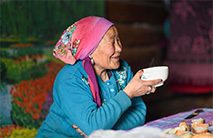Feature: Italian architects proud of contribution to Beijing Winter Olympics venue
ROME, Feb. 3 (Xinhua) -- On the eve of the Beijing 2022 Olympic Winter Games, a Visitor Center transformed from a former oxygen factory of an industrial complex jointly by Italian architects and their Chinese colleagues is ready for athletes and guests.
At the foot of the Big Air Shougang, the venue for the Big Air competitions (snowboarding and freestyle skiing), the visitor center was designed by the Polytechnic University of Turin, host city of the 2006 Winter Olympics.
"An area of some nine million square meters -- seven times larger than the area occupied by the World Expo hosted by Milan in 2015 -- is gradually becoming a district returned to urban life with all its necessary connections," recalled Michele Bonino, one of the Italian architects.
The Polytechnic University has been collaborating with the Beijing-based Tsinghua University since 2008, and they have organized joint research and academic programs since 2012. It took four years of close collaboration to finalize the plans for the project.
The visitor center, in the heart of Shougang, a repurposed industrial complex of iron and steel plants, was born from the renovation of a portion of a former Oxigen Factory right at the entrance of the Olympic complex.
As a whole, Bonino explained, the master plan for Shougang was a key example of urban regeneration, whose aim was to gradually return a huge industrial area to the city.
"The skeleton of the old factory has been maintained intact, while inside it, a new structure made of concrete and glass has been designed. It is suspended from the ground and almost floating," the architect said.
Using an innovative design, the new structure leaves the visitor center's ground floor almost unsupported. "This creates a sort of covered public plaza below, which would welcome visitors at the beginning of their Olympic experience," he explained.
In a recent statement, Guido Saracco, rector of the Polytechnic University, said that they were proud to have directly contributed to the Beijing 2022 Olympic Winter Games.
For a long time and until a few decades ago, Turin had been an industrial city, and the experience developed in renovating and reusing its industrial heritage might also have played a role in the Chinese architects' decision to assign the project to their Italian colleagues, Bonino said.
The Italian team of architects included four PhD students. Camilla Forina, 30-year-old, was one of them and coordinated the production of materials at the China Room of Polytechnic University. Two such students completed their dual doctoral programs with Tsinghua.
The plan for the visitor center was born out of a series of expert meetings at the Polytechnic University involving designers, structural and plant engineers and other specialists.
"In this way, we approached the working method of the Chinese universities, where it is normal practice for students and professors to work side by side on field projects," Forina said.
Photos
Related Stories
- Interview: Tajik president says happy for Beijing to become world's first dual Olympic city
- China lose to Czech Republic in Beijing Games women's ice hockey opener
- Double celebration of Spring Festival, Winter Olympics brings China closer to world
- Beijing 2022 starts new era for global winter sports: IOC President
- Former KMT chairperson invited to attend Beijing Winter Olympics opening ceremony
- Looking forward to attending Beijing Winter Olympics, bolstering ties with China -- Ecuadorian president
Copyright © 2022 People's Daily Online. All Rights Reserved.










